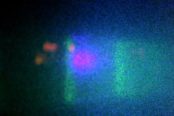[dropcap style=”font-size:100px; color:#992211;”]F[/dropcap]or tens of thousands of years animals have depended upon the effects of spots, stripes or a combination thereof to protect them from predators.
Unfortunately, after some research involving a few humans playing computer games, it turns out that nature, evolution and the myriad creatures of the heights and deeps of the planet have been doing it ALL WRONG!
Stupid animals. All that time wandering around the Serengeti. Bet they don’t even have GoPros.
Stripes might not offer protection for animals living in groups, such as zebra, as previously thought, according to research published in Frontiers in Zoology. Humans playing a computer game captured striped targets more easily than uniform grey targets when multiple targets were present. This rebukes assumptions that stripes evolved to make it difficult to capture animals moving in a group.
Anna Hughes, University of Cambridge, says “We found that when targets are presented individually, horizontally striped targets are more easily captured than targets with vertical or diagonal stripes. Surprisingly, we also found no benefit of stripes when multiple targets were presented at once, despite the prediction that stripes should be particularly effective in a group scenario. This could be due to how different stripe orientations interact with motion perception, where an incorrect reading of a target’s speed helps the predator to catch its prey.”
Stripes, zigzags and high contrast markings make animals highly conspicuous, which you might think would make them more visible to a predator. Researchers have wondered if movement is important in explaining why these patterns have evolved. Striking patterns may confuse predators and reduce the chance of attack or capture. In a concept termed ‘motion dazzle’, where high contrast patterns cause predators to misperceive the speed and direction of the moving animal. It was suggested that motion dazzle might be strongest in groups, such as a herd of zebra.
‘Motion dazzle’ is a reference to a type of camouflage used on ships in World War I and II, where ships were patterned in geometric shapes in contrasting colors. Rather than concealing ships, this dazzle camouflage was believed to make it difficult to estimate a target’s range, speed and heading.
A total of 60 human participants played a game to test whether stripes influenced their perception of moving targets (images available). They performed a touch screen task in which they attempted to ‘catch’ moving targets, both when only one target was present on screen and when there were several targets present at once.
Animal Camouflage
When single targets were present, horizontal striped targets were easier to capture than any other target, including uniform color, or vertical or diagonal stripes. However, when multiple targets were present, all striped targets, irrespective of the orientation, were captured more easily than uniform grey targets.
“Motion may just be one aspect in a larger picture. Different orientations of stripe patterning may have evolved for different purposes. The evolution of pattern types is complex, for which there isn’t one over-ruling factor, but a multitude of possibilities. More work is needed to establish the value and ecological relevance of ‘motion dazzle’. Now we need to consider whether color, stripe width and spatial patterning, and a predator’s visual system could be important factors for animals to avoid capture,” says Anna Hughes.
Source: BioMed Central
Image: Jyoti Bindu

Some of the news that we find inspiring, diverting, wrong or so very right.




















